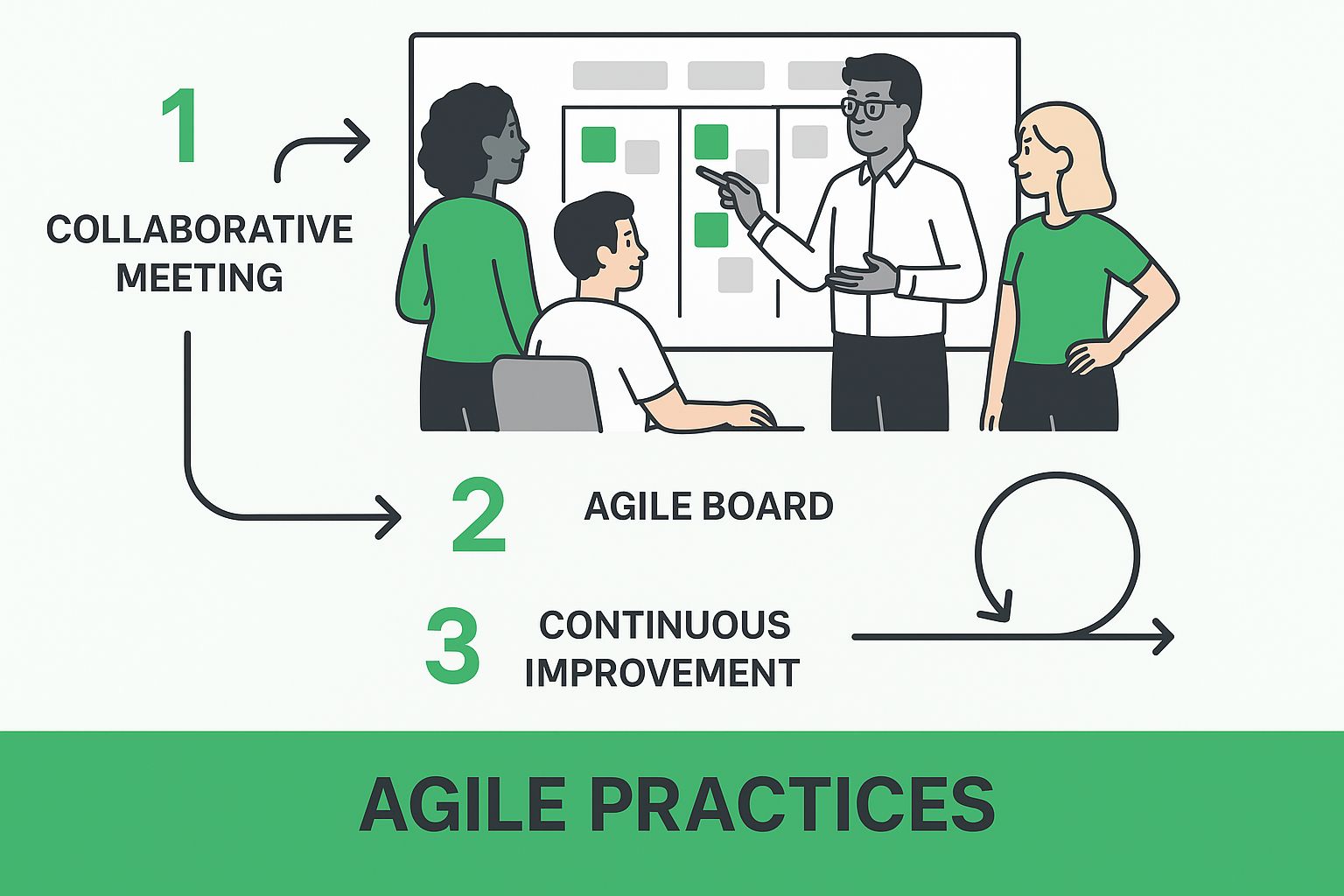A practical guide to software development process improvement. Learn to audit workflows, implement agile/devops, and use metrics to boost team efficiency.
When you’re trying to build better software, you can’t just throw more developers at the problem. Real, lasting improvement comes from a smarter approach—a strategic mix of Agile thinking, a DevOps culture, clever automation, and a constant focus on quality.
Getting these pieces to work together is what builds a resilient and adaptable team. The end game? Shipping superior products faster, preventing team burnout, and leaving your competition wondering how you do it.

The pressure to deliver high-quality software at a breakneck pace is relentless. In this environment, letting your development process get stale isn’t just inefficient—it’s a massive business risk. Every delay, budget overrun, or buggy release chips away at customer trust and opens the door for competitors.
This means that refining your workflow isn’t some “nice-to-have” item on a quarterly checklist. It’s a core strategic necessity for survival and growth.
We’re not talking about minor tweaks here. This is about taking a hard look at the entire software development lifecycle—from the first whiteboard sketch to post-deployment support—and hunting down every point of friction to maximize the value you deliver. The goal is a system that’s not just fast, but also predictable, reliable, and ready to pivot when needed.
At the heart of modern software process improvement is the widespread shift to Agile methodologies. For over two decades, Agile has fundamentally changed the game, moving teams away from rigid, top-down models. It’s not just a trend; the results speak for themselves.
An overwhelming 61% of companies worldwide now run on Agile, which has proven to be 1.5 times more successful than old-school Waterfall approaches. Four out of five organizations swear by Agile for its ability to handle shifting priorities—in fact, 64% report a huge improvement in this area. It also shines a light on the whole process, a benefit noted by 40% of companies. For a closer look at the data, you can check out the latest software development statistics.
This quote from the quality management legend hits the nail on the head. Even your most brilliant developers will get bogged down by a broken system. When you fix the process, you empower the entire team to do their best work.
To truly overhaul your development engine, you need to understand the key components that drive real success. Think of them as pillars holding up a stronger structure. Each one tackles a specific challenge in the software lifecycle, and together, they create a powerful, self-reinforcing system of continuous improvement.
Here’s a quick breakdown of the concepts that form the foundation of any solid process improvement strategy.
These aren’t just buzzwords; they are practical blueprints for building a more efficient and less stressful development environment. Adopting them represents a cultural shift toward collaboration, shared ownership, and making decisions based on data, not just gut feelings.
By focusing on these areas, you move your team from a reactive, fire-fighting mode to a proactive state of predictable, high-quality delivery. That’s how you build a real, sustainable competitive advantage.
You can’t fix what you can’t see. Before you can even think about improving your software development process, you have to get brutally honest about where you are right now. This means digging past the official org charts and process docs to uncover what your team actually does day-to-day.
Most teams think they’re following a certain playbook, but the on-the-ground reality is often a messy collection of tribal knowledge, informal handoffs, and clever workarounds. The point of an audit isn’t to point fingers; it’s to draw a clear line in the sand. This is your baseline, the “before” picture against which every future win will be measured.
First things first: you need to visualize your entire software development lifecycle (SDLC) as it truly operates. Get the key players in a room—someone from product, a few devs, a QA engineer, maybe an ops person—and literally map out the journey of a single feature, from idea to production.
Forget what the official handbook says. Ask the real questions to get to the ground truth:
This exercise is almost always an eye-opener. You might discover that your developers are sitting idle for an average of two days waiting for a code review. That’s a silent productivity killer, and it’s not the reviewer’s fault—it’s a bottleneck baked into your process.
With your workflow map sketched out, you can start hunting for the biggest sources of pain and delay. These are the friction points where a little bit of effort will deliver the biggest results. Look for the common culprits that drag down your delivery speed and sap team morale.
A classic real-world example is the handoff between development and QA. I’ve seen teams where 30% of tickets got bounced back from QA immediately. The reason? Missing details or simple configuration mistakes. That’s not a QA failure; it’s a “Definition of Done” failure that needs to be fixed much earlier in the cycle.
Treat it like a detective story. You’re gathering clues and following the evidence to find the root cause of every delay.
A truly insightful audit blends hard numbers with human experience. You need both to understand the full story.
Quantitative Data (The “What”):
This is the cold, hard evidence of your process’s performance. Track these key metrics:
Qualitative Data (The “Why”):
This is where you uncover the context behind the numbers.
When you combine these two, you get a powerful narrative. Your data might show a high Change Failure Rate, but the interviews reveal it’s because the manual deployment process is a 20-step nightmare. Suddenly, you have a crystal-clear case for investing in automation. This foundational audit gives you the irrefutable evidence you need to justify change and build a smarter software development process improvement strategy.
Let’s be honest, talking about Agile and DevOps is easy. Making them actually work for your team? That’s where the real challenge begins. These aren’t magic wands you can wave to fix your development process. If you just slap the labels on without changing how you operate, you’ll end up with more bureaucracy, not less.
The whole point is to adopt these practices in a way that genuinely helps your team get things done, not just pile more meetings onto their calendars. It’s about focusing on the results—like a sprint that delivers real value or a retrospective that sparks actual change—instead of just going through the motions.
I’ve seen too many teams that say they “do Agile” but get none of the benefits. Why? Because their ceremonies have become empty rituals. A daily stand-up that drags on for 30 minutes while everyone gives a status report to the manager isn’t a stand-up. It’s a waste of time. To fix this, we need to get back to the original intent of these meetings.
This is how all those distinct agile practices come together, creating a collaborative environment where work flows smoothly.

The key takeaway is that these aren’t just isolated meetings. They’re all connected parts of a system built to improve communication and make steady, iterative progress. If you want to go deeper on this, our guide on essential software development best practices provides a lot more valuable context.
The whole “Scrum vs. Kanban” debate often misses the point. It’s not about which one is better overall, but which one is the right fit for your team and your project. Making the right choice here can have a massive impact on your day-to-day workflow.
To help you decide, here’s a quick breakdown of how they compare.
Think of it this way: a startup building a brand-new product might love the structure of Scrum to keep everyone marching toward a launch date. On the other hand, a platform team juggling bug fixes and urgent customer requests would probably benefit more from Kanban’s flexibility to manage a constant stream of work.
DevOps isn’t a tool you can buy or a job title you can hand out. It’s a fundamental shift in how your teams think and work together. It’s all about knocking down that invisible wall that has historically stood between your development and operations teams. This doesn’t happen overnight; it’s a gradual change you have to nurture.
The core idea is shared ownership. When something breaks in production, it’s not an “ops problem” or a “dev problem”—it’s a team problem. This simple shift encourages developers to think about how their code will behave in the wild and gets operations folks involved much earlier in the process.
When you fully embrace this culture, you’ll see developers on the on-call rotation and operations engineers contributing directly to the application’s codebase. The end goal is one cohesive team that owns the entire lifecycle of a service, from the first line of code to how it performs for the end-user. This holistic view is the real engine behind improving your software development process.
Let’s be honest: automation is the powerhouse of any modern software delivery pipeline. We’re not just talking about basic scripting here. Real, strategic automation turns your pipeline into a smart, self-running system. This frees up your developers to do what you hired them for—solving tough business problems, not babysitting builds.
The goal isn’t just speed. It’s about making your entire development process more reliable, predictable, and resilient. When you properly automate your pipeline, you stamp out the tedious, error-prone manual work that kills productivity. By turning your build, test, and deployment processes into code, you establish a single source of truth that guarantees every single change gets the same rigorous quality treatment.
The absolute heart of pipeline automation is Continuous Integration and Continuous Deployment (CI/CD). If you’re serious about any kind of software development process improvement, this is where you start. It’s the practice where every code change is automatically built, tested, and prepped for release without anyone lifting a finger.
But a truly great CI/CD pipeline is much more than a glorified compiler. Think of it as your most vigilant quality gatekeeper.
This instant feedback loop is a game-changer. Instead of a developer finding out days later that they broke something, they know within minutes. That slashes the time and cost of fixing issues.
Suddenly, you’re moving away from those high-stress, “big bang” release weekends to a calm, continuous flow of improvements.
We’ve all heard it: “but it works on my machine!” This classic headache almost always comes down to tiny, maddening differences between development, testing, and production environments. The definitive cure for this is Infrastructure as Code (IaC).
With IaC, you manage your infrastructure—your servers, databases, and networks—using simple configuration files. Instead of a sysadmin manually clicking through a console to set up a server, you write code that defines exactly what that server should look like. This approach is a lifesaver.
When you treat your infrastructure like software, it becomes predictable, repeatable, and far less vulnerable to human error.
Now, Artificial Intelligence is pushing automation into a whole new league. The trend is undeniable: the most efficient dev teams are handing off cognitive work to intelligent tools. By 2025, the very idea of software development process improvement will be completely intertwined with AI.
The numbers don’t lie. A staggering 92% of developers in the US are already using AI coding tools. We’re even seeing startups build products where up to 95% of the code is AI-generated.
This is exactly where tools like AI coding assistants and automated documentation generators, such as DocuWriter.ai, are making a huge impact. These tools don’t just automate typing; they automate the creation of critical artifacts that support the entire development process. Imagine automatically generating perfect API documentation with every single code change—your docs would never be stale again.
This saves countless developer hours and removes a major point of friction for any team that needs to use your services. AI is becoming a true partner in the process, handling the grunt work so your developers can stay focused on high-level architecture and innovation.

If you’re not measuring your development process, you’re just guessing. To make any real improvements, you have to look past the vanity metrics and dig into the numbers that reveal the true health of your engineering system.
These numbers aren’t about micromanaging people or playing the blame game. Think of them as diagnostic tools for your entire workflow. The first step is to get a solid handle on key software development metrics. When you use them right, they give everyone a shared, objective way to talk about problems and see if the solutions are actually working.